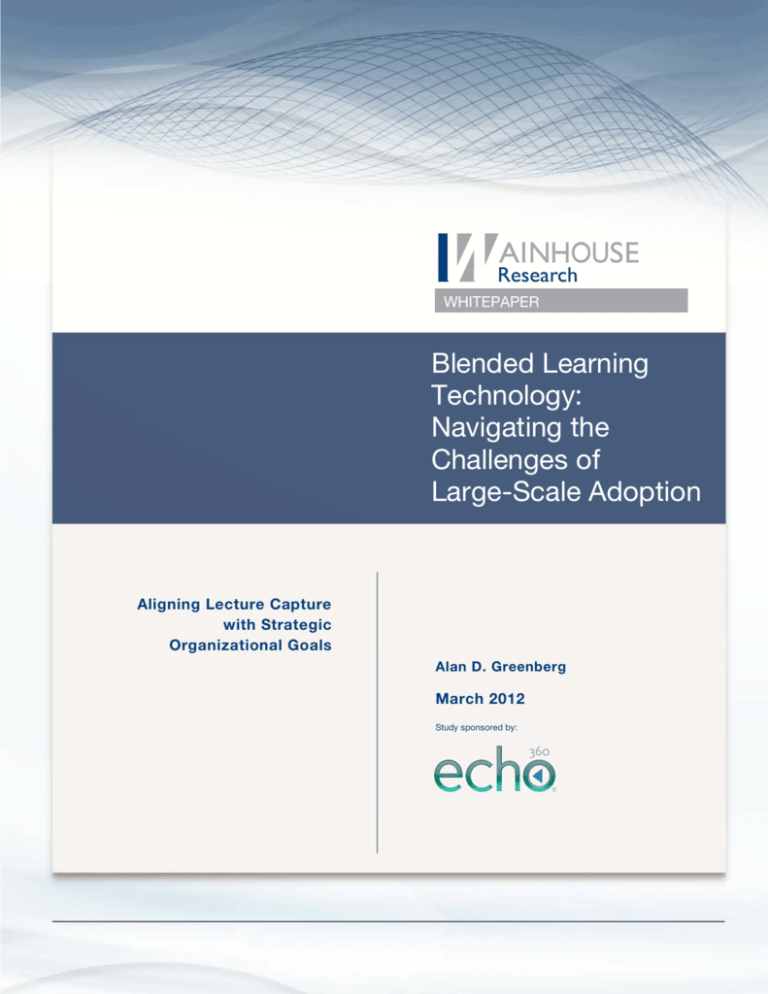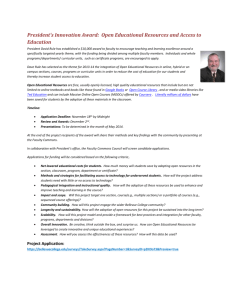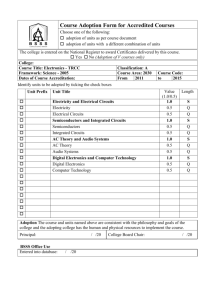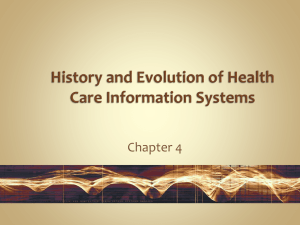
Blended Learning Technology: Navigating the Challenges of Large-Scale Adoption
WHITEPAPER
Blended Learning
Technology:
Navigating the
Challenges of
Large-Scale Adoption
Aligning Lecture Capture
with Strategic
Organizational Goals
Alan D. Greenberg
March 2012
Study sponsored by:
Copyright © 2012 Wainhouse Research, LLC
Page 1
Blended Learning Technology: Navigating the Challenges of Large-Scale Adoption
Contents
Executive Summary ................................................................................................................................. 3
Methodology........................................................................................................................................... 4
Why Paths to Campus-Wide Adoption Matter ......................................................................................... 4
Why Driving Adoption is Challenging ....................................................................................................... 5
Five Successful Deployments ................................................................................................................... 7
George Washington University – The Mission Critical....................................................................... 7
Wayne State University – Piloting, Partnerships, and Business Process Re-Engineering .................... 7
Qatar University – Innovations in Teaching and Learning in the Midst of the Arab Spring ................. 7
Monash University – Student Demand and the University Mission ................................................... 8
University College London – Finding Champions, Evolving Applications............................................ 9
How Organizations Can Drive Adoption ................................................................................................... 9
Policy .................................................................................................................................................... 12
Five Summary Tips for Driving Adoption ................................................................................................ 13
About the Author .................................................................................................................................. 15
About Wainhouse Research................................................................................................................... 15
About Echo360 ...................................................................................................................................... 15
Figures
Figure 1. Five Key Elements to Driving Adoption ..................................................................................... 7
Tables
Table 1. Ten Advisory Actions and Their Impact on Obstacles ................................................................ 10
WR Paper: Blended Learning Technology: Navigating the Challenges of Large Scale Adoption
Copyright © 2012 Wainhouse Research. All rights reserved.
Copyright © 2012 Wainhouse Research, LLC
Page 2
Blended Learning Technology: Navigating the Challenges of Large-Scale Adoption
Executive Summary
A blended learning solution often calls for a platform for capturing in-class and out-of-class activities and
content, and delivering it live or on demand to students. In just a few short years, colleges and
universities have come to understand the many benefits of blended learning, from pedagogical to
administrative. Lecture capture is one method of achieving blended learning.
In many institutions, introducing technology into the classroom presents opportunities – and obstacles
to overcome. The introduction of any new technology – no matter how transparent or easy to use –
requires changed behaviors. In education, the challenges can be grouped into three key areas: cultural,
process, and academic. Any of these can hinder achieving return on investment and the ability to
leverage – and scale – blended learning technologies. While the benefits of these technologies are
many, identifying and building on them requires strategy and preparation.
This white paper, based on interviews with five universities as well as Wainhouse Research’s
observations of best practices, identifies five compelling lessons about how to best drive adoption of
lecture capture. The lessons include:
Business value
Inter-departmental cooperation
Academic quality
Student satisfaction
Champions
The paper examines the five universities in detail, describing how each has found its own unique path to
successful adoption of blended learning technologies. The paper also offers ten specific steps to
overcome cultural, process, or academic obstacles. These are, in short:
1.
2.
3.
4.
5.
6.
7.
8.
9.
10.
Understand adoption cycles
Involve the right people
Clone your champions
Identify benefits to your overall institution & map goals of deployment
Plan extensively while remaining flexible and open to revising those plans
Create a consistent service model
Design sustainable policies
Create substantive processes for measurement
Encourage peer review
Leverage best of breed capture and delivery mechanisms
Copyright © 2012 Wainhouse Research, LLC
Page 3
Blended Learning Technology: Navigating the Challenges of Large-Scale Adoption
The paper also offers a number of suggestions for addressing the issue of policy, which is so important in
academic settings. Understanding how best to create policy can enable colleges and universities to
harness and maximize the return on current or future investments in blending learning technologies.
Methodology
Wainhouse Research interviewed five universities that have healthy adoptions of lecture capture
underway, and combined that research with past findings from surveys, presentations, and other
sources concerning best practices for driving adoption of a blended learning solution. Specific
individuals and organizations interviewed for this paper are distributed across the globe, and include:
John Arpino, Assistant Director of Engineering Research and Development, Academic
Technologies, The George Washington University, Washington, D.C., USA
Janette Burke, Director Central Services and University Copyright Officer, Monash University,
Clayton, Victoria, Australia
Dr. Peter Jewesson, Professor and Dean, College of Pharmacy, Qatar University, Qatar
Dr. John Mitchell, Senior Lecturer, Department of Electronic and Electrical Engineering,
University College London, UK
Dr. Sandra Yee, Dean of the Library System, and Joseph Sawasky, CIO and Associate Vice
President for Computing and Information Technology, Wayne State University, Detroit,
Michigan, USA
By interviewing a cross-section of types of institutions based in different geographies, the goal has been
to identify many different factors that can support adoption.
Why Paths to Campus-Wide Adoption Matter
A blended learning solution offers a platform for capturing audio, video, in-class and out-of-class
interactions, and data such as curricular content and delivering it real-time and – more importantly – on
demand to students. It incorporates the best of lecture capture, video streaming, multimedia, archival,
search, and social media to enhance learning. In just a few short years, colleges and universities have
come to understand the many benefits of the technology, including:
Enhanced recruitment and retention of students
Opportunities for new programs
Opportunities for new revenue streams
The ability to address millennial students’ expectations and demand for enhanced technologies
in the classroom (student satisfaction)
Improved instructor effectiveness
In many but not all cases, improved grades
Copyright © 2012 Wainhouse Research, LLC
Page 4
Blended Learning Technology: Navigating the Challenges of Large-Scale Adoption
Lecture capture is an ideal tool for delivering blended learning – learning that is facilitated by the
effective combination of different modes of delivery and models of teaching and styles of learning…1 As
a result, it has found a home in both traditional brick-and-mortar institutions seeking to improve their
offerings to local learners through the on-demand archival of classes, as well as distance learning or
online programs that reach remote students via real-time or on demand technologies.
Why is it so important that adoption be pervasive and that the ability exists to introduce it to an entire
organization?
First and foremost, the best way to optimize return on investment is to maximize usage. This is a given
in organizations that pay attention to total cost of ownership and how they leverage investments in
technology. The average cost of deploying decreases as an organization leverages technology
investments, infrastructure, and support / training time. Yet increasing usage through IT is not always a
clear-cut proposition: adding software, appliances, equipment and routers, and other infrastructure
does not in itself grow usage.
Secondly, an institution considering deployment of lecture capture must consider the issue of scalability.
Scalability is the ability of a system, network, or process, to handle growing amounts of work in a
graceful manner or its ability to easily adapt to accommodate that growth. 2 Yet as scalable a system or
technology solution may be, growth-impeding obstacles can interfere even as the adoption of a
technology is set to take off. This paper serves as a set of guidelines for driving adoption.
A more scalable blended learning platform results in:
Greater ROI
Greater ability to meet the mission of the organization
Enhanced harmony and satisfied faculty
Greater ability to serve students
Why Driving Adoption is Challenging
In many institutions, the introduction of technology into the classroom presents several obstacles to
overcome. Chief among these is that adoption of any new technology – no matter how transparent or
easy to use it may be – requires changed behaviors. And every educational institution has its own
unique DNA leading to its degree of willingness to embrace new technologies. The challenges can be
grouped into three key areas, and are somewhat simple to identify, though not always easy to address:
Cultural – What is the blend of attitudes towards technology and pedagogy?
1
Heinze and Procter
André B. Bondi, 'Characteristics of scalability and their impact on performance', Proceedings of the 2nd International
Workshop on Software and Performance, Ottawa, Ontario, Canada, 2000, ISBN 1-58113-195-X, pages 195 - 203
2
Copyright © 2012 Wainhouse Research, LLC
Page 5
Blended Learning Technology: Navigating the Challenges of Large-Scale Adoption
Process – In what ways can an organization best address workflow to ensure seamless
adoption?
Academic – How does lecture capture fit into the pedagogical goals of a college or university,
and how can it be seen as an effective academic tool that enhances an educator’s ability to
engage with students?
It is not unusual for institutions to face challenges and decision points that can influence successful
deployment:
How to deploy technology. Should it be hosted on premises (onsite and within an
organization’s campus firewalls)? In the Cloud? Or employ a hybrid model?
Staffing. Who “owns” the responsibility of ensuring that everything works? How much staff
time will it require?
Instructor resistance. How can you get faculty to accept the new and novel? How do you
create policies that ensure acceptance?
Funding. Where is the money coming from: grants? Student fees? Endowment or capital
expenditure reserves?
Fears about policy, privacy and copyright issues. Instructors may resist or fear mandated
behaviors or policies over which they feel they lack control. Similarly, who “owns” the content
once it is recorded, and how does that content interplay with an educator’s own intellectual
property?
Lack of understanding concerning efficacy. Is this technology improving grades? Or is that the
proper metric for measurement?
The realities concerning which type of program or area of study may readily adopt lecture capture can
sometimes go against the grain of conventional wisdom. Where hard sciences, medical, and business
schools were among the earliest adopters of lecture capture,
many organizations find other pockets of acceptance. At
"For lecture capture to be embraced
George Washington University for example, the Humanities
by academics, the university needs to
are major users of lecture capture.
understand and articulate the
educational rationale for the service.”
Successfully deploying lecture capture takes work. It requires
Janette Burke, Monash University
inter-departmental and inter-functional area cooperation
(process), combined with openness to technology (the cultural) and appreciation of new pedagogical
approaches (the academic). Fortunately, lessons in successfully deploying lecture capture can be
learned from several institutions that have paved the way.
Copyright © 2012 Wainhouse Research, LLC
Page 6
Blended Learning Technology: Navigating the Challenges of Large-Scale Adoption
Five Successful Deployments
Each of the five successful deployments described in this
paper offers its own compelling lesson – with a key
takeaway – about how to best drive adoption of lecture
capture. Figure 1 summarizes key elements / situational
criteria that help drive adoption.
Academic
quality
InterDepartmental
Cooperation
Learner
George Washington University – The Mission
Champions
satisfaction
Critical
The largest institution of higher education in the District
of Columbia (with 20,000 FTE students), GWU is
Business value
comprised of three major campuses and several graduate
education centers located in the D.C. area.
Figure 1. Five Key Elements to Driving Adoption
Since 2006, GWU has introduced lecture capture into 32
classrooms across two campuses, and is seeking to expand to another campus in 2012. Many
established programs have integrated lecture capture, and the
“Adoption has been driven mostly by
university – like many others – publishes availability of
faculty and students, along with the
captured classes to iTunes University and Blackboard. Key
support of our administration, so we
Takeaway: Business value. GWU views lecture capture as
have seen demand from everyone.”
mission critical in an environment where high-profile programs
John Arpino, George Washington
in foreign affairs, business, government, and political science
University
hold sway, but the technology has been equally adopted by
other areas.
Wayne State University – Piloting, Partnerships, and Business Process Re-Engineering
With almost 32,000 students participating in more than 400 academic programs, WSU’s main campus in
Detroit comprises 100 buildings over nearly 200 acres. In addition, five extension centers offer higher
education to students throughout southeast Michigan. After the entire organization displayed strong
interest in lecture capture, WSU’s Dean of the University’s Library System and its Chief Information
Officer teamed to establish a large pilot running in 47
classrooms, combining a mix of rich media lecture capture with “The bang you get for the buck from
more limited audio/data capture. Key Takeaway: Interthis kind of technology is not indirect.
departmental cooperation. Eighteen months of planning prior
It is immediate and realizable for
students and faculty.”
to the pilot – which involved collaboration between many
different elements of the university system – and project
Joe Sawasky, Wayne State University
management helped lead to a very successful program.
Qatar University – Innovations in Teaching and Learning in the Midst of the Arab Spring
Established in 1973 as its country’s first national school of education, Qatar University has evolved into
the country’s sole publicly funded university, serving more than 7,000 male and female students.
Copyright © 2012 Wainhouse Research, LLC
Page 7
Blended Learning Technology: Navigating the Challenges of Large-Scale Adoption
Its seven colleges offer a total of 60 specializations. Lecture
capture has been introduced to the students and instructors of
“We are trying to establish a culture of
the university’s College of Pharmacy in a new light: as a means
accountability and transparency and
of improving teaching first and foremost. Policies on peer
we are delivering a progressive North
American pharmacy curriculum in a
mentoring and faculty review of other academics take on a
part of the world where pharmacy
whole new slant on this almost paperless campus. The
education tends to lag behind. We
number of classes captured and made available, attitudes
are educating students whose first
about openness of content, student-centered access, and even
language is Arabic. All of our content
approaches to testing are influenced by the desire to improve
is English. Add a third, professional
teaching. The result has been a remarkable multi-year
language, ‘Pharmacese’ and you can
program that teaches students fundamental concepts today
appreciate the challenges this poses
and how they will be applied when making life and death
for a pharmacy student in Qatar. We
decisions on behalf of their patients in the future. Key
know students struggle when they
Takeaway: Focus on academic quality and challenging cultural hear rapid speech, variable accents,
colloquialisms, and slang and we
assumptions. Policy can be mandated based on “newness” of
strive to avoid this. Lecture capture
programs but it helps to integrate that policy with other
serves multiple purposes (for our
factors, such as organizational mission. At Qatar University,
students.) by permitting them to revisit
improvements in teaching and learning are the focus. Qatar
the instruction and discussion in the
University’s goal is to become a leading teaching university
classroom whenever, wherever and
with an emphasis on establishing a reputation as a modern,
as often as they want before
paperless and technologically-driven university. Students can
graduation.”
look forward at courses to be offered in the future and revisit
Dr. Peter Jewesson, Qatar University
anything from the past. About 80% of the college’s learning
resources are electronic. “This has a profound impact on how we deliver education. Suppose we find a
mistake that affects test outcomes; it’s an excellent way to be proactive and encourage students to
question everything. There is a reason our region is going through the Arab Spring. We want students to
challenge everything. We champion evidence-based decision making.”
Monash University – Student Demand and the University Mission
Australia’s Monash University has used lecture capture since the 1990’s, starting with its own
homegrown technology. The university is quite familiar with the benefits of lecture capture and has
expanded its use, with all six of its Australian campuses using the technology and two international
campuses trialing the service. On average 1,032 lectures are recorded in 101 theaters equipped with
Echo360. Many of the 62,550 students demand lecture
“We know from students’ perspectives
capture: viral demand began in the late 1990’s and shows no
sign of abating. The university has navigated the need to match that they value the service and are
using it in droves. They do not see
its deployment with the organization’s overall mission, and the
lecture capture as an optional extra,
library provides leadership of the service. Not all programs are
but as an essential learning tool.”
appropriate for lecture capture, based on privacy or cultural
Janette Burke, Monash University
reasons, and a number of academic steering committees
Copyright © 2012 Wainhouse Research, LLC
Page 8
Blended Learning Technology: Navigating the Challenges of Large-Scale Adoption
create appropriate policy around implementation of lecture capture, taking into consideration
copyright, privacy, intellectual property, national laws and cultural norms. Monash also has a tiered (or
graded) system of high tech lecture theatres, standard and studio rooms that determine where the
technology will be placed, in conjunction with the teaching methods and pedagogical goals of the
academics and faculty instructors. Key Takeaway: Student demand and satisfaction can be integral to
adoption. Monash University established an approach to placing recordings in one centralized location
so that they could conveniently be managed. This improved turnaround time from recording to
availability. And “with consistent access points, the user experience is much better.”
University College London – Finding Champions, Evolving Applications
Ranked seventh among the world’s top ten universities by QS Work University Rankings, UCL wanted to
get serious about a more structured approach to lecture capture. Their initial experience with
technology saw various groups within the university “doing their own thing” with podcasting, YouTube,
and other recording mechanisms UCL had been providing utilizing roll-about trolleys. Seeking a more
scalable solution, UCL deployed a 22-room pilot across the campus, which has grown to more than 50
classrooms. More than 40% of its 24,000 student body is
“We see lecture capture as
engaged in graduate studies, with the medical school,
contributing to the reinvention of the
Economics, and Engineering all relying heavily on lecture
student as learner, giving flexibility,
capture for post graduate education. Key Takeaway: Find
which is a big deal at the moment.
Champions. UCL’s approach was to make lecture capture
We have an obligation to work to that,
ubiquitous where possible and then identify champions who
and from the student feedback it’s
could illustrate the benefits to other programs. Those
clear they like it, and think it has
helped.”
champions are essential in helping to identify and articulate
specific performance improvements.
Dr. John Mitchell, University College
How Organizations Can Drive Adoption
London
Successful adoption and scale calls for an understanding of a number of factors that address the three
challenges described earlier – cultural, process, and academic – and taking steps to accommodate these
factors.
Ten “advisory approaches” will be useful to many organizations. Table 1 highlights our advisories and
where they touch on the three major obstacles. Taking these steps to address the cultural, process, or
academic obstacles will help your organization successfully drive adoption.
Understand the cycles that drive adoption. They can be top down, bottom up, or across the
board. At Wayne State University, lecture capture became a natural add-on to an existing
podcasting capability. In addition, the library system became interested in moving to a
standardized approach to lecture capture that integrates with its existing support infrastructure,
which includes Blackboard and media services support and the Office for Teaching and Learning.
Copyright © 2012 Wainhouse Research, LLC
Page 9
Blended Learning Technology: Navigating the Challenges of Large-Scale Adoption
Cultural
Process
Academic
Understand adoption cycles / drivers
Involve the right people
Clone your champions
Identify benefits to your overall institution
& map goals of deployment
Plan extensively while remaining flexible
and open to revising those plans
Create a consistent service model
Design sustainable policies
Create substantive processes for
measurement
Encourage peer communication
Have best of breed capture and delivery
mechanisms
Table 1 Ten Advisory Actions and Their Impact on Obstacles
Find opportunities to identify demand – who needs or wants it and why. Qatar University is
branching out to use lecture capture for professional development, capturing College of
Pharmacy Professional Development events and research seminars and making them available
to anyone (inside or outside the university) who may be interested. For example, there is
demand inside Qatar and elsewhere – and even some non-middle-eastern pharmacists have
been accessing its PD content.
Involve the right people. Every single successful organization appears to include multiple
functional areas that work together to help lecture capture become rooted in the institution. At
Wayne State, it is IT and library services (along with the academic technology advisory group,
with IT staff and teachers from each school and college advising the central IT group and library
services). According to Wayne State’s Sawasky, “It helped maintain momentum, with IT sharing
governance. We weren’t just focusing on faculty or technologists, but involved both groups.”
The resulting team understood that “we need to involve the academics. We set up a steering
committee, which is still running and which will work on our next level of adoption of lecture
capture as well as other opportunities for new software and functionality.”
Clone your champions. University College London initially focused on engaging with likely
champions and then built upon those successes to find other opportunities. Those champions
are actively seeking to identify the pedagogical impact of blended learning to support further
adoption.
Identify benefits unique to your institution and map the goals of a lecture capture deployment
to the goals of the university (whether financial, pedagogical, or overall mission). Wayne State
Copyright © 2012 Wainhouse Research, LLC
Page 10
Blended Learning Technology: Navigating the Challenges of Large-Scale Adoption
University saw both the academic and business benefits, and was very interested, according to
Joe Sawasky, in the “ability to scale. If it is reliable enough and scalable enough to do a lot more
with only a few additional systems, in the end it will help us contain and avoid significant
increases in operational expenses.”
Plan extensively while remaining flexible and open to
“We had strong partners in this
revising those plans. Every organization interviewed
project. The partnership aspect is the
planned extensively with inter-departmental
most compelling part of our approach.
organizations. Wayne State spent 18 months,
It was an 18-month process to plan for
achieving buy-in from many different departments
this and we sought buy-in from many
different departments. Faculty
and committees and ensuring that policies were
members were interested in making
sufficient to promote adoption, not inhibit it.
students able to review content even if
Create a consistent service model. Wayne State
they were coming to all classes ”
University took a minimal cost and ease of access
Dr. Sandra Yee, Wayne State
approach to its centralized services. There are no
University
charge backs to individual departments unless they
wish to buy extra equipment beyond that which was
supplied through an initial purchase fund comprised of student fees. Dr. Sandra Yee and Joe
Sawasky agree: “The notion of providing low cost or free service to departments helps shape
behaviors and provides a real benefit. It is hard to refuse something that is free or low cost.
And we offer significant storage space (not without some limits) and are here to help everyone
with scheduling, which has resulted in an easy and predictable pathway for our internal users.”
Create sustainable policies (retention of content, management of content, security, opt-in or
opt-out) that address faculty fears, e.g., that students will stop coming to class. Some
universities face privacy issues and literally are unable to record certain programs. Monash
University created an academic steering committee with representation from IT, Library and
student services that established policies regarding the use of lecture capture, particularly
addressing copyright and privacy concerns. The steering committee literally drove the
implementation process at Monash. Policies concerning retention of content can actually
support the process of encouraging faculty adoption based on how they are structured.
Create measurements. Scores, retention rates, recruitment numbers, student surveys, faculty
performance, and review measurements (monitoring how often and when students review
content) are all methods of measuring the impact of blended learning. Each year, George
Washington University produces a report required by its funding mechanism that measures
areas like numbers of course captures, downloads and streams of actual content, how many
courses are included in the program, and any unique faculty behaviors. Many of the
organizations interviewed for this paper have ambitious plans to begin measuring these areas in
the coming years.
Encourage peer communication to build a holistic educational program. This is a relatively novel
concept in most colleges and universities, where academics are comfortable with peer research
paper review but less accustomed to the authorized access to peer instructional content,
Copyright © 2012 Wainhouse Research, LLC
Page 11
Blended Learning Technology: Navigating the Challenges of Large-Scale Adoption
including lecture capture. At Qatar University, Dr. Jewesson states “A professor teaching
therapeutics will be a subject matter expert in this area, but may benefit from a refresher on the
underlying pathophysiology of the disease in question. By reviewing a fellow faculty member’s
related pathophysiology lectures, they can get an update, enter the classroom and say, ‘I know
Professor X delivered this last week. I know exactly what he/she said so now we’ll build on
that.’” As the pharmacy curriculum is heavy, the college rule is to avoid delivering redundant or
conflicting material. “If you inadvertently deliver anything that has already been taught, it
means you haven’t determined the student’s learning needs before stepping into the classroom.
You are potentially wasting a student’s time and you can expect students to challenge you in
this regard. This changes the dynamic in the relationship between student and faculty
significantly, and adds a heightened level of accountability.” Lecture capture also produces
archived content that provides a quality assurance mechanism, presenting an opportunity for
peer assessment of teaching for improvement and academic promotion purposes, and it
contributes to the creation of a comprehensive record of the instruction provided. This record is
critical when developing learning assessment instruments, and Dr. Jewesson states “students
are encouraged to respectfully challenge the professor if there is any discrepancy between the
content delivered and the assessments undertaken. Once again, this is accountability and
transparency in action.”
Have best of breed capture and delivery mechanisms. Simple tools that date back to the early
days of podcasting, iTunes University, and YouTube are a far cry from a university-based,
enterprise-wide approach to course capture and management. “Standardization, in terms of
support, has been helpful. (Library services) supports classroom technology and IT provides the
back end ‘wires.’ By standardizing on this equipment, we can provide better support,” says
Wayne State University’s Dr. Yee.
Policy
In the course of speaking with many involved with lecture capture deployment, Wainhouse Research
has identified what is arguably the single biggest impediment to successful adoption: uncertainty
concerning policy. Many organizations attempt to achieve academic approval and acceptance by
creating policies that are designed to play to educator comfort levels. When politics are at play, it may
seem that the path of least resistance is the safest route. Thus we have seen some of the following
policies at various universities:
Opt-out, where the educator may decide he/she may not be recorded
Opt-in, where the educator decides if he/she is willing to be recorded and if recordings may be
released
Record and opt-in, where the educator is required to be recorded but has the option of deciding
if recordings may be released
Record, no questions asked, where the educator is recorded and must participate and use the
technology, but where limits may be set on who gets to view the recordings.
Copyright © 2012 Wainhouse Research, LLC
Page 12
Blended Learning Technology: Navigating the Challenges of Large-Scale Adoption
Record, no questions asked, where the content is made available to the entire world, as is the
case at some high-profile institutions like MIT.
Policies also vary concerning whether or not students may be recorded, how long recordings are
maintained, and types of courses that are appropriate and preferred for capture. Among the
institutions interviewed for this paper, most of the organizations have some type of policy:
George Washington University has Echo360, iTunes University, and Blackboard policies, and
they tie together. The university keeps the course archives but after the semester has
concluded, students no longer have access. Faculty can review their captured courses for two
years after the end of semester, and then the course is retired.
Qatar University College of Pharmacy mandates recording and availability of captured lectures –
but unless the material is specifically for professional development / continuing education, only
faculty and registered students are allowed to review degree program lectures. In a Middle
Eastern country where being recorded on camera might be unwelcome and where cultural
norms limit gender mixing, these issues need to be addressed before lecture capture is
introduced.
Monash University keeps access within its security wall to minimize any copyright and privacy
concerns related to material that might be captured. 3 To be certain that guest lecturers may
feel comfortable being frank, sometimes these captured lectures are edited.
Wayne State University has an opt-in policy, but had to quickly address a rumor that faculty
were going to be automatically recorded and that the recordings would be made public. Some
faculty members were concerned about the reuse of intellectual property. Wayne State
determined that its existing policies already addressed these issues and no new policies were
required.
University College London has created its own set of takedown, archiving, and retention policies.
Concerns existed regarding what would happen if material was stolen and could possibly reappear years later. Digital watermarking became an important element of ensuring that control
is maintained over their content. As many as 10 to 12 diverse groups within the university were
responsible for developing the language in the final policy documents.
These examples speak to the need for an institution to market and evangelize. A significant amount of
communicating is necessary, especially surrounding intellectual property rights.
Five Summary Tips for Driving Adoption
With as much diversity as exists among the colleges and universities interviewed for this paper,
nonetheless several aspects are common across the board. These five behaviors can be found to varying
degrees at all five organizations:
3
Some universities alternatively make all captured courses universally available. Again, this relates to the mission and culture of
each particular university.
Copyright © 2012 Wainhouse Research, LLC
Page 13
Blended Learning Technology: Navigating the Challenges of Large-Scale Adoption
Creation of solid inter-departmental / inter-functional
partnerships
Understanding of academic / pedagogical implications
/ goals and how to tie them into the overall
organizational goals
Creation of unique policies appropriate for the specific
organization
Understanding of the importance of measurement and
assessment
Deployment of technology that is scalable, sustainable,
rock solid, easy-to-use and well supported.
“We’re great believers that access to
relevant content by the right people at
the right time is a good thing. It’s part
of our culture to also make learning
resources freely available to our
clinical affiliates. We are also using
lecture capture for continuing
pharmacists’ professional
development events. They can’t all
be here for these events, so we make
the content of the sessions freely
available to them on our website, and
to anyone in the world for that matter.”
Many technology champions often have the drive necessary to
foster adoption, yet “flying solo” has its consequences. Of all
Dr. Peter Jewesson, Qatar University
lessons, perhaps the greatest observation that can be made is
that lecture capture – like many other collaborative technologies – requires its share of co-pilots,
navigators, and others to help steer and drive adoption.
For many in higher education, lecture capture is becoming central to a strategy for digital education,
wherein it is one of multiple tools that will help post-secondary education rise to the task of improving
its ability to educate learners in a digital age. Adopting the approaches discussed in this paper will help
many organizations get beyond the pilot phase and truly embed the technology in their organizational
DNA, as is being accomplished at the five organizations described here.
Monash University knows from the measurements it has created that “students love and demand
lecture capture, and they like the flexibility. However, deployment simply as a response to student or
faculty demand is not enough. Optimal deployment— and utilization—without overwhelming faculty
and students, requires that colleges and universities carefully consider the steps and tips offered in this
paper.
Copyright © 2012 Wainhouse Research, LLC
Page 14
Blended Learning Technology: Navigating the Challenges of Large-Scale Adoption
About the Author
Alan D. Greenberg is Senior Analyst & Partner at Wainhouse Research, with special expertise in
distance education and e-Learning. Alan is co-lead analyst on WR’s WebMetrics web conferencing
survey program. He has conducted research into dozens of distance learning networks and e-learning
users, was product marketing manager for a set of turnkey classroom packages, and has led a number of
educational and training initiatives. Most recently he authored the three-volume segment report The
Distance Education and e-Learning Landscape and authored numerous white papers and reports on
lecture capture, web conferencing, videoconferencing, and interactive whiteboards as applied for
education and e-Learning. He also has consulted to many states, universities, and regional educational
consortia on distance education strategies, and received the 2010 Outstanding Leadership by an
Individual in the Field of Distance Learning award from the U.S. Distance Learning Association. Alan
holds an M.A. from the University of Texas at Austin and a B.A. from Hampshire College. He can be
reached at agreenberg@wainhouse.com.
About Wainhouse Research
Wainhouse Research, www.wainhouse.com, is an independent market research firm hat focuses on
critical issues in the Unified Communications and rich media conferencing fields, including applications
like distance education. The company conducts multi-client and custom research studies, consults with
end users on key implementation issues, publishes white papers and market statistics, and delivers public
and private seminars as well as speaker presentations at industry group meetings. Wainhouse Research
publishes a variety of reports that cover all aspects of rich media conferencing, and the free newsletter,
The Wainhouse Research Bulletin.
About Echo360
As a global leader in blended learning and lecture capture products, Echo360 helps higher education
institutions keep pace with modern students’ learning needs through products that digitally record and
upload learning content. Echo360 has been recognized with a Product Line Strategy of the Year Award
from Frost & Sullivan and named a Visionary Vendor in Educational Technology by IT research firm
Basex. Echo360’s products facilitate better instruction for large collections of students, lower costs and
enrich learning experiences by enabling students to easily access and share multimedia content. Through
Echo360’s platform, students can replay recorded sessions and review information from instructors online,
at their convenience and across various devices. Echo360’s products are used by 500 institutions in 28
countries.
Copyright © 2012 Wainhouse Research, LLC
Page 15








